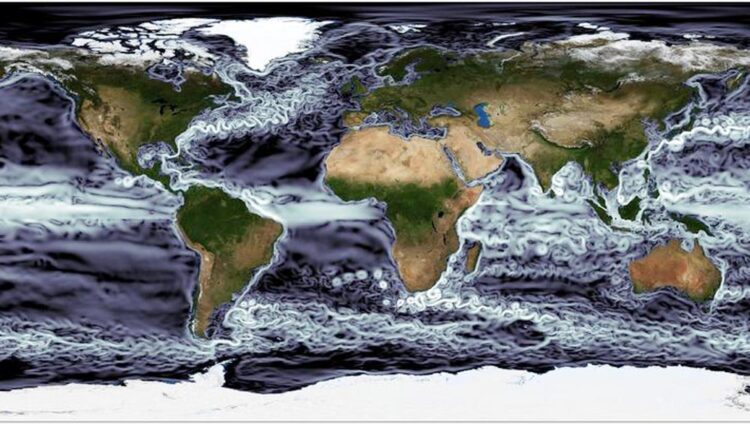How eddies affect our climate

Global map of eddies
(c) Nathan Beech / Alfred-Wegener-Institut
New EU project to use supercomputers for improved Earth system simulations.
The ocean has a large effect on our planet’s climate. In this regard, mesoscale – i.e., medium-sized – eddies, which constitute essentially the weather on the ocean, could be far more important than previously believed. Accordingly, a new project, led by the Alfred Wegener Institute has just been launched in order to more precisely assess this aspect: by doing so, “European Eddy Rich Earth System Models” (EERIE) could significantly improve today’s Earth system models and therefore projections of the climate’s future development.
Eddies come in a range of sizes, with diameters from only a few metres to several kilometres. Their influence on the climate depends on their size. Although the existence of these eddies has been known about for some time, we still have limited quantitative information on their role, also bearing in mind the impacts of a warming climate (Beech et al. 2022). A new EU-financed project aims to change that: with the aid of “European Eddy Rich Earth System Models” (EERIE), eddies will be more realistically represented in climate models – i.e., by the laws of physics rather than empirical parametrisations.
EERIE’s goal is to help produce a new generation of Earth system models (ESMs). To do so, it will focus on improving the simulation of mesoscale eddies, which, depending on the region, can be anywhere from five to 40 kilometres wide. The modelling improvements will include e.g. the inclusion of open channels of water (“leads”) in sea ice, where the ocean influences the atmosphere via powerful heat fluxes. “The technological hurdles to achieving these high-resolution simulations are immense,” says Prof Thomas Jung, responsible for coordinating the project at the Alfred Wegener Institute, Helmholtz Centre for Polar and Marine Research (AWI). “In order to allow quantitative statements, EERIE will have to achieve a simulation rate of up to five simulated years per day on the latest pre-exascale supercomputers available in Europe. Here, efficiency is a key factor – also to keep the simulations’ energy consumption and CO2 footprint to a minimum.” In order to implement, save and analyse these complex high-resolution simulations, the researchers will have to work hand in hand with software engineers to develop radically new software technologies.
In the course of the project, the researchers also plan to develop new simulation protocols, contributing to national and international climate change assessments in the process. In this way, EERIE is to yield useful and directly applicable climate information, and to make valuable contributions in preparation for the IPCC’s next Assessment Report.
The project budget is over 10 million euros. 17 partner institutions are involved, including seven universities. The kick-off event for EERIE took place on 23 and 24 February 2023. The project, which officially began on 1 January 2023, will continue for four years.
Wissenschaftliche Ansprechpartner:
Prof. Dr. Thomas Jung, phone +49(0) 471 4831-1761; email: Thomas.Jung@awi.de
Weitere Informationen:
https://www.awi.de/en/about-us/service/press/single-view/wie-ozeanwirbel-unser-k…
Media Contact
All latest news from the category: Information Technology
Here you can find a summary of innovations in the fields of information and data processing and up-to-date developments on IT equipment and hardware.
This area covers topics such as IT services, IT architectures, IT management and telecommunications.
Newest articles

Why getting in touch with our ‘gerbil brain’ could help machines listen better
Macquarie University researchers have debunked a 75-year-old theory about how humans determine where sounds are coming from, and it could unlock the secret to creating a next generation of more…

Attosecond core-level spectroscopy reveals real-time molecular dynamics
Chemical reactions are complex mechanisms. Many different dynamical processes are involved, affecting both the electrons and the nucleus of the present atoms. Very often the strongly coupled electron and nuclear…

Free-forming organelles help plants adapt to climate change
Scientists uncover how plants “see” shades of light, temperature. Plants’ ability to sense light and temperature, and their ability to adapt to climate change, hinges on free-forming structures in their…





















